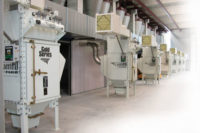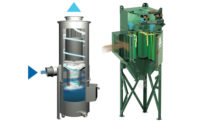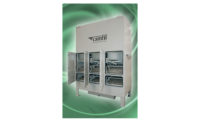
Over the past decade, cartridge-style dust collectors have overtaken baghouses as the preferred technology for industrial dust collection. Combining high-efficiency filtration with compact size and reduced pressure drop, a high-efficiency cartridge dust collector will usually be the system of choice.
Environmental and safety personnel today must deal with an increasingly complex alphabet soup of regulations as the EPA, OSHA and other organizations continue to tighten air quality and safety requirements. Meeting these requirements should be first and foremost in any dust collection game plan. The following FAQ addresses the most important safety considerations when making an informed dust collection decision.
Will my dust collector comply with emission requirements?
OSHA has established permissible exposure limits (PEL) for hundreds of dusts ranging from nonspecific or “nuisance” dust to highly toxic substances. These limits are based on an 8-hour time-weighted average (TWA) exposure. Further information on PELs can be found at www.osha.gov/SLTC/pel/.
One area of concern involves stricter limits on exposure to hexavalent chromium, a known carcinogen. OSHA has set thresholds as low as 5 micrograms (0.005 milligram) per cubic meter TWA. This is 10 times stricter than the limits for some other toxic dusts. Dust collectors need to be equipped with very high efficiency filtration media to meet such requirements.
How do you know if your dust collector complies with emission thresholds? The equipment supplier should provide a written guarantee stating the maximum emissions rate for the equipment over an 8-hour TWA. Filter efficiency stated as a percentage is not an acceptable substitute, even if the supplier promises 99.9 percent efficiency.
Do I have a combustible dust issue?
The National Fire Protection Association’s NFPA 68 Standard on Explosion Protection by Deflagration Venting provides stringent and mandatory requirements for dust collection applications involving explosive dusts. The change from a guideline to a standard is enforced by OSHA, which has a National Emphasis Program focusing on the safe handling of combustible dusts. OSHA is also developing a comprehensive federal safety standard on combustible dust.
The explosive power of a dust is denoted as “Kst,” the rate of pressure rise. For more information, go to http://www.dguv.de/ifa/ en/gestis/expl/index.jsp. This website lists the combustion and explosion characteristics of more than 4,000 dusts. The database provides a useful reference point, although it is not a substitute for dust testing. To determine whether your particular dust is combustible, it must undergo explosibility testing in accordance with ASTM test methods.
Explosive dusts can be organic or metallic in nature and are present in a long list of manufacturing industries, including agricultural, chemical, food, paper, pharmaceutical, textile and woodworking. Under the new directives, any dust with a Kst value >0 is considered to be potentially explosive. To ensure compliance, many plants now have to install updated dust collection/explosion venting equipment.
Will my collector fix the problem?
What else is the dust collector expected to do? Perhaps it must reclaim valuable product, maintain a higher level of cleanliness in manufacturing areas, accommodate changes or expansions in the plant, or solve a performance problem experienced with an older dust collection system.
A good way to pinpoint objectives is by using a site survey form available from most equipment suppliers. This form typically calls for information on the process and the material to be collected, operating hours and conditions, electrical requirements, airflow and pressure ratings, and other application specifics.
The survey will also call for detailed information on the physical properties of the dust. To determine these properties, the dust should be tested using a series of bench tests available from independent laboratories and many equipment suppliers. This testing is in addition to the explosibility testing mentioned above, and the results will help determine the best dust collector design and filter media for your application.
Is the collector optimally equipped for safe, reliable operation?
While the most basic function of a dust collector is to keep workers and workplaces safer, not all collectors are created equal from a safety standpoint. Here are some key features to consider as you work with your equipment supplier:
OSHA-compliant railed safety platforms and caged ladders can prevent slips and falls when workers access the collector for service. Lockout/ tagout doors prevent injury caused by inadvertent opening of doors during a pulsing cycle and/or exposure to hazardous dust. Where highly toxic dust is being handled, a bag-in/bag-out (BIBO) containment system may be required to isolate workers from used filters during change-out.
Ease of filter change-out should be explored. Are the filter cartridges positioned for ease of access? Do they readily slide in and out of the housing? Pulling out a 100-pound dirty overhead filter can result in neck, back and foot injuries, so make sure the collector you choose is service-friendly.
Consider vertical cartridge mounting. Some pleated filter cartridges are mounted on their sides. With horizontal mounting, the dust does not get cleaned off the top of the filters, and there is no pre-separation of heavy or abrasive particles from the air stream. This situation can shorten filter life or, in spark-generating applications, pose a fire or explosion hazard. An antidote to this problem is a system using vertically mounted cartridges. Vertical designs reduce the load on the filters and help eliminate the problems described above.
Fire and explosion prevention must also be optimized. A range of features and technologies can be employed, from vertical mounting to the use of flame-retardant filter media to spark arrestors and sprinkler systems. Where explosive dusts are present, approved explosion vents and/or other components will be needed for controlled deflagration.
You might also want to equip your collector with a safety monitoring filter. This is a secondary bank of high-efficiency air filters that prevent collected dust from re-entering the workspace if there should be a leak in the dust collector’s primary filtering system.
A safety monitoring filter is a required component in a recirculating dust collection system that recycles air downstream of the collector. By recirculating heated or cooled air back through the plant, the cost to replace that conditioned air is eliminated. Many plants report five- to six-figure annual energy savings. Another advantage of recirculating systems is a reduction in regulatory paperwork. By containing the air indoors, you can avoid the time-consuming EPA permitting involved when contaminated air is exhausted outside.


